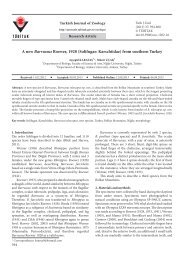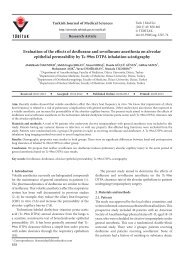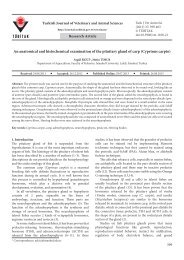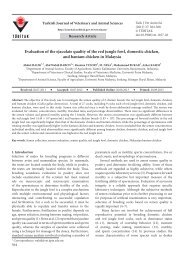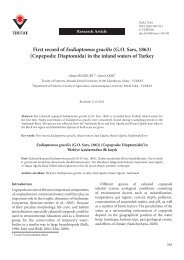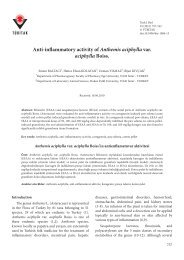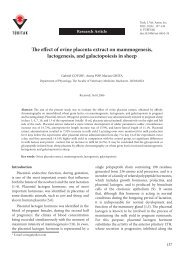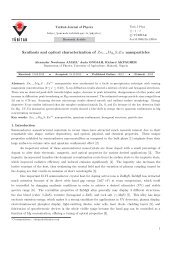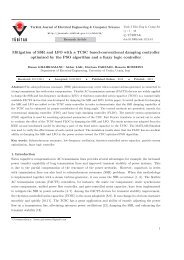Preliminary study on Acropora - Scientific Journals - Tübitak
Preliminary study on Acropora - Scientific Journals - Tübitak
Preliminary study on Acropora - Scientific Journals - Tübitak
You also want an ePaper? Increase the reach of your titles
YUMPU automatically turns print PDFs into web optimized ePapers that Google loves.
4. Discussi<strong>on</strong><br />
Because of the high morphological plasticity of staghorn<br />
corals (Todd, 2008), differences in the estimates of species<br />
diversity in these corals might be expected in any given<br />
area. Such differences, however, should be within a<br />
reas<strong>on</strong>able range. A number of studies carried out <strong>on</strong><br />
the corals of the southern part of the Persian Gulf (Riegl,<br />
1999; Wallace, 1999; Coles, 2003) showed that between<br />
11 and 13 <strong>Acropora</strong> species inhabit the area. That number<br />
for the northern and northeastern parts was <strong>on</strong>ly 5, which<br />
included <strong>Acropora</strong> clathrata (Maghsoudlou, 2008, 2011),<br />
before this <str<strong>on</strong>g>study</str<strong>on</strong>g>. In the present <str<strong>on</strong>g>study</str<strong>on</strong>g>, 9 staghorn corals<br />
were found, excluding <strong>Acropora</strong> clathrata and A. phara<strong>on</strong>is,<br />
which have frequently been reported (Maghsoudlou, 2008,<br />
2011; Mostafavi et al., 2010) from Iranian coasts of the<br />
Persian Gulf. If the records of A. phara<strong>on</strong>is were deemed<br />
valid, the number of <strong>Acropora</strong> species of the northern and<br />
northeastern parts of the Persian Gulf would reach at least<br />
10. It should also be menti<strong>on</strong>ed that from our specimens,<br />
C.C. Wallace identified A. horrida, A. mossambica, A.<br />
muricata, and A. tortuosa as ‘c<strong>on</strong>fer’ (cf.). The provisi<strong>on</strong>al<br />
identificati<strong>on</strong>s were caused by the small sizes of those<br />
specimens. More and closer examinati<strong>on</strong> of specimens<br />
from the same dives and of additi<strong>on</strong>al specimens collected<br />
later <strong>on</strong> allowed us to c<strong>on</strong>firm the identificati<strong>on</strong>.<br />
Nevertheless, taking into account the reports of other<br />
species from the southern part of the Persian Gulf, namely<br />
A. valenciennesi (Milne-Edwards and Haime, 1860 )<br />
(Sheppard and Sheppard, 1991; Wallace, 1999), A. y<strong>on</strong>gei<br />
Ver<strong>on</strong> and Wallace, 1984, A. selago (Studer, 1878), A.<br />
divaricata (Dana, 1846) (Wallace, 1999), A. tenuis (Dana,<br />
1846), and A. florida (Dana, 1846) (Riegl, 1999), the total<br />
number of species of <strong>Acropora</strong> for the Persian Gulf would<br />
be at least 16.<br />
<strong>Acropora</strong> is not <strong>on</strong>ly the richest but also the most<br />
abundant coral genus in the Persian Gulf, so much so that<br />
in some places al<strong>on</strong>g Larak Island the coverage by this<br />
genus is 100% (Rahmani, 2012). Fossil records suggest<br />
that <strong>Acropora</strong> has been the dominant coral <strong>on</strong> this island<br />
at least since the Pleistocene (Samimi-Namin and Riegl,<br />
2012). Regardless of the number of <strong>Acropora</strong> ancestral<br />
species in the Europe-Western Indian Ocean regi<strong>on</strong> during<br />
the Miocene (which were resp<strong>on</strong>sible for the diversity and<br />
dominance of the modern <strong>Acropora</strong> of the Indo-Pacific<br />
during the Plio-Pleistocene), <strong>Acropora</strong> species of the Indo-<br />
Pacific are derived from their ancestral line(s) coming from<br />
the Europe-Western Indian Ocean regi<strong>on</strong> that diversified<br />
and dispersed during the Late Oligocene to the Miocene<br />
(Wallace and Rosen, 2006). Evidence for <strong>Acropora</strong><br />
dominance in the Western Indian Ocean can be found<br />
in the Larak outcrops, too (Samimi-Namin and Riegl,<br />
2012). C<strong>on</strong>sidering the repetitious (Riegl, 1999, 2002)<br />
and periodical (Shinn, 1976) mass mortalities am<strong>on</strong>g the<br />
RAHMANI and RAHIMIAN / Turk J Zool<br />
<strong>Acropora</strong> species and their 15–20 years of successi<strong>on</strong> cycles<br />
in the Persian Gulf, and also keeping the young nature of<br />
the Persian Gulf in mind (Wallace and Muir, 2005) (water<br />
began entering the Gulf <strong>on</strong>ly 12,500 years ago (Lambeck,<br />
1996)), evaluati<strong>on</strong>s of ecological factors in additi<strong>on</strong> to<br />
evoluti<strong>on</strong>ary and historical factors are necessary in order<br />
to <str<strong>on</strong>g>study</str<strong>on</strong>g> the reas<strong>on</strong>s behind the relatively high diversity<br />
and abundance of <strong>Acropora</strong> in the Persian Gulf.<br />
However, in this part of the Persian Gulf, A. downingi<br />
and A. arabensis are abundant, and A. valida is observed<br />
to a lesser extent than the former 2 species (Maghsoudlou,<br />
2008; Rahmani, 2012).<br />
Except these 3 species, the rest can be defined as rare<br />
species, accounting for <strong>on</strong>ly about 5% of the <strong>Acropora</strong><br />
coverage (Rahmani, 2012). N<strong>on</strong>e of these corals, however,<br />
are listed as vulnerable (Askari, 2012), and no or very few<br />
special protecti<strong>on</strong> measures have been applied to c<strong>on</strong>serve<br />
these species.<br />
The necessity of c<strong>on</strong>servati<strong>on</strong> acti<strong>on</strong>s <strong>on</strong> behalf of the<br />
coral reefs in this area is obvious c<strong>on</strong>sidering the severe<br />
c<strong>on</strong>diti<strong>on</strong>s the Persian Gulf ecology must bear, especially<br />
its temperature, salinity (Coles, 1988; Coles and Fadlallah,<br />
1991; Coles 1992; Riegl, 1999; Coles, 2003), and red<br />
tides, as well as anthropological activities including wars,<br />
offshore oil drilling, tanker traffic, ballast water discharge,<br />
the c<strong>on</strong>structi<strong>on</strong> of several artificial islands, development<br />
of coastal areas, and destructi<strong>on</strong> of coral reefs by divers.<br />
The need to c<strong>on</strong>serve the corals of the Persian Gulf is even<br />
more urgent c<strong>on</strong>sidering the c<strong>on</strong>tinuous trend of global<br />
warming and the fact that the Persian Gulf is a breeding<br />
ground for warmth-tolerant species of the future.<br />
As menti<strong>on</strong>ed earlier, A. clathrata was not observed<br />
during the present work. This species has been reported as<br />
a comm<strong>on</strong> and dominant species by Maghsoudlou (2008,<br />
2011). Such an abundant, comm<strong>on</strong>, and dominant species<br />
could hardly be missed in an intensive sampling program.<br />
C<strong>on</strong>sequently, it seems that either A. clathrata does not<br />
exist in these parts of the Persian Gulf, or it occurs at a very<br />
low density (see remarks <strong>on</strong> A. downingi). However, the<br />
authors believe that the reports of A. clathrata in this area<br />
were, in fact, the result of a misidentificati<strong>on</strong>/c<strong>on</strong>fusi<strong>on</strong><br />
between the 2 forms of A. downingi. Further studies are<br />
necessary to definitely c<strong>on</strong>firm the presence or absence of<br />
A. clathrata in the Persian Gulf.<br />
Coles (2003) suggested that the coral species of the<br />
Persian Gulf are a small sample of a larger fauna of the<br />
Indo-Pacific area and maintained that the Acroporidae<br />
account for 16% of the total coral species of the Persian<br />
Gulf. This <str<strong>on</strong>g>study</str<strong>on</strong>g> changed that proporti<strong>on</strong> in the Persian<br />
Gulf to 25%. This value is much closer to the proporti<strong>on</strong><br />
of Acroporidae species to all corals species of the Indo-<br />
Pacific (30%). The 5% difference could be the result of the<br />
envir<strong>on</strong>mental stresses in the Persian Gulf.<br />
317



